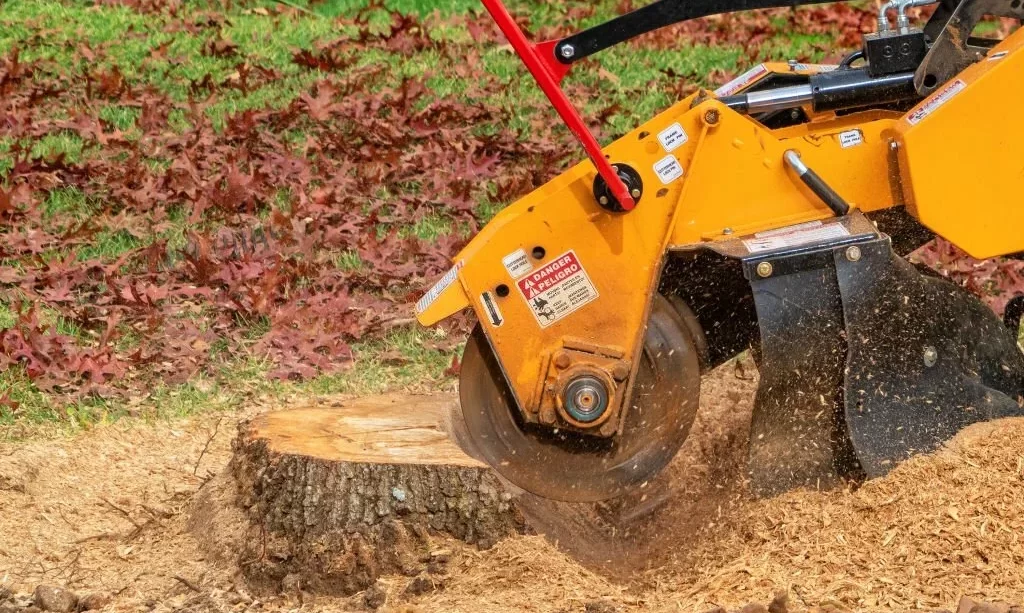When it comes to the removal of tree stumps from your yard, stump grinding is a common and effective solution. This process involves the use of specialized machinery to reduce a tree stump to wood chips or sawdust, eliminating a potentially unsightly and hazardous obstacle. While the fate of the stump itself is clear – transformed into mulch or wood debris – what happens to the roots of the tree often remains a lesser-discussed aspect. In this article, we’ll delve into the intricacies of stump grinding and explore the journey the tree’s roots embark on after the stump has been ground.
The Stump Grinding Process
Understanding what happens to the roots after stump grinding begins with grasping the process itself. Stump grinding is typically carried out using a powerful grinder specifically designed for this purpose. The grinder features a rotating cutting wheel with sharp teeth that chips away at the stump. As the operator guides the machine, the stump is gradually reduced to wood chips or sawdust, effectively eliminating the visible portion of the tree’s base. The result is a clear and level surface where the stump once stood, often making the area suitable for landscaping or other purposes.
The Fate of the Stump
After the stump has been ground, what remains is a heap of mulch or wood debris – a visible reminder of the tree’s existence. This material can be used for various purposes, including mulching your garden or filling in the hole left by the stump’s removal. The benefits of this outcome are significant, as it reclaims yard space, removes tripping hazards, and prevents new shoots from sprouting from the stump’s base. However, what happens below the ground, to the roots, is a topic that warrants further exploration. The fate of the roots is often a combination of natural decay and, in some cases, specific actions taken by the property owner.
What About the Roots?
After the stump has been ground and the visible remains reduced to mulch or wood debris, you may wonder what becomes of the tree’s extensive root system. Unlike the stump, which is efficiently transformed during the grinding process, the roots do not disappear entirely. They remain beneath the ground, hidden from sight but not from the forces of nature. The fate of these roots is influenced by a combination of factors, including the tree species, root size, environmental conditions, and any actions taken by the property owner. Understanding the post-grinding life of the roots sheds light on the complex process of natural decomposition and its impact on your yard.
Natural Decay and Decomposition
Once the stump is ground, the roots left underground begin to undergo a process of natural decay and decomposition. Microorganisms, including bacteria and fungi, play a crucial role in breaking down the organic matter within the roots. As these microorganisms feed on the decaying material, they convert it into valuable nutrients that enrich the surrounding soil. This gradual breakdown is part of the cycle of life and death in a forest or garden ecosystem, contributing to the renewal and fertility of the soil. Over time, the roots become a source of nourishment for the earth, promoting the growth of other plants and organisms.
Impact on Soil Health
The decomposition of tree roots left underground following stump grinding has several positive effects on soil health. As the roots break down, they improve soil aeration, making it easier for water and oxygen to penetrate the ground. Additionally, the decaying organic matter enhances the soil’s nutrient content, creating a more fertile environment for plant growth. This enrichment benefits not only the grass and plants in your yard but also the entire ecosystem that relies on healthy soil. The outcome of root decomposition contributes to a thriving and vibrant landscape, serving as a testament to the intricate interplay of nature’s processes.
Understanding the post-stump-grinding life of tree roots is essential for those seeking to make informed decisions about their yard. Whether you choose to leave the roots to naturally decompose or opt for more immediate removal, this understanding empowers you to manage your outdoor space in a way that aligns with your landscaping goals and the health of your soil.
Root Removal Options
While the natural decay and decomposition of tree roots can be a beneficial process for your yard, there are circumstances in which you might consider taking more immediate action. Several root removal options are available for those who prefer not to wait for nature to take its course. These options include manual root removal, which involves physically digging out the remaining roots, and the use of specialized equipment like a stump grinder or a backhoe to extract the roots. The choice of method largely depends on the size of the roots, their depth, and your specific landscaping needs. Before deciding on root removal, it’s essential to evaluate the situation and consider the long-term impact on your yard.
How Long Does Decomposition Take?
The timeline for root decomposition varies and is influenced by several factors. The species of the tree, the size of the roots, the environmental conditions, and the presence of microorganisms all play a role in determining how quickly the roots break down. In general, the process of natural decomposition can take several years, with smaller roots decomposing more rapidly than larger ones. The exact duration may also be influenced by the health of the soil, with well-aerated and nutrient-rich soil facilitating faster decomposition. Understanding that this process is gradual and requires patience is essential for property owners, as it helps set realistic expectations regarding the timeline for complete root decay.
Conclusion
The aftermath of stump grinding brings both a visible transformation of the stump into mulch or wood debris and a less visible but equally important transformation of the tree’s roots below the ground. As these roots undergo natural decay and decomposition, they contribute to the soil’s health and fertility, benefitting the overall ecosystem of your yard. However, the decision of whether to leave the roots in place or to pursue more immediate removal is a choice that depends on various factors, including your landscaping goals and the specific conditions in your yard. Understanding the process and timeline of root decomposition empowers property owners to make informed decisions about their outdoor spaces, allowing them to strike a balance between the needs of their landscape and the benefits of natural decay.



